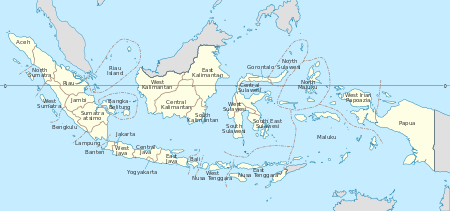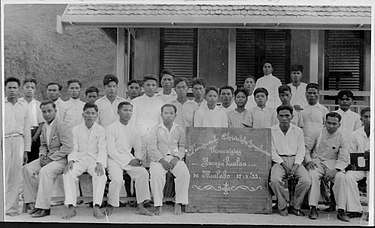Subdivisions of Indonesia
 |
|---|
| This article is part of a series on the politics and government of Indonesia |
| Pancasila (national philosophy) |
| Constitution |
|
Executive |
|
|
|
| Foreign relations |
Indonesia is divided into provinces (Indonesian: Provinsi). Provinces are made up of regencies and cities. Provinces, regencies and cities have their own local governments and parliamentary bodies.
Since the enactment of Law Number 22 Year 1999 regarding Local Government[1] (the law was revised by Law Number 32 Year 2004[2]), local governments now play a greater role in administering their areas. Foreign policy, defence (including armed forces and national police), system of law, and monetary policy, however, remain the domain of the national government. Since 2005, heads of local government (governors, regents and mayors) have been directly elected by popular election.[3]
First level
A province is headed by a governor. Each province has its own regional assembly, called Dewan Perwakilan Rakyat Daerah (literally meaning "Regional People's Representatives Assembly"). Governors and representative members are elected by popular vote for five-year terms.
Indonesia is divided into 34 provinces.[4] Eight provinces have been created since 2000. Five provinces have special status:
- Aceh (also known as Nanggroe Aceh Darussalam (formerly: Aceh Special Region), has greater role in local government, which includes its own Islamic Sharia law (for Muslim citizens), flag and provincial anthem, local political parties are allowed, and decisions or laws made by the central government which directly affect Aceh's administration must be referred to the local government or legislative body.[5]
- Yogyakarta Special Region. The Sultan of Yogyakarta is de facto and de jure governor of Yogyakarta since he is given priority when electing the governor. For centuries, the Sultanate of Yogyakarta has reigned in the region.[6] However, recently the central government proposed a law that required the governor to be popularly elected as in the other provinces, while still giving the sultan significant political power. Since 31 August 2012 The Law of Specialty of Yogyakarta Special Region has been approved by Central Government and according to the Law, Yogyakarta refuses to be a province but it is a region at province-level.[7][8][9]
- Papua (formerly: Irian Jaya), since 2001 local government has a greater role. The governor is required to be of Papuan origins.[10]
- West Papua (formerly: Irian Jaya Barat), has the same status as Papua.
- Jakarta Special Capital Region, is the capital of Indonesia. The Governor of Jakarta has the power to appoint and dismiss mayors and regent within the Jakarta Special Capital Region. The local government is allowed to co-operate with other cities from other countries.[11]

Second level

picture credits : Tropenmuseum.
Regency (Indonesian: Kabupaten) and city (Indonesian: Kota), collectively known as "Daerah Tingkat II"[12] is a local level of government beneath the provincial level. However, they enjoy greater decentralisation of affairs than the provincial body, such as provision of public schools and public health facilities.
Both regency and city are at the same level, having their own local government and legislative body. The difference between a regency and a city lies in differing demographics, size and economics.
Generally the regency has a larger area than the city, and the city has non-agricultural economic activities. A regency is headed by a regent (Indonesian: Bupati), and a city is headed by a mayor (Indonesian: Wali kota). The regent or mayor and the representative council members are elected by popular vote for a term of 5 years.
Third level
Regencies and cities are divided into:
- Kecamatan (sub-district)[13] headed by a camat. A camat is a civil servant, responsible to the regent (in a regency) or to the mayor (in a city). Kecamatan are found in most parts of Indonesia.
- Distrik (district)[13] headed by a kepala distrik (district chief). Distrik are only found in the provinces of Papua and West Papua and are the equivalent of kecamatan in the rest of Indonesia.
Fourth level
Kecamatan and distrik are divided into desa (villages) or kelurahan (urban communities). Both desa and kelurahan are of a similar division level, but a desa enjoys more power in local matters than a kelurahan. An exception is Aceh, where districts are divided into mukim before being subdivided further into gampong.
Desa
In Indonesian, as in English, a village (desa) has rural connotations. In the context of administrative divisions, a desa can be defined as a body which has authority over the local people in accordance with acknowledged local traditions of the area. A desa is headed by a "head of village" (Indonesian: kepala desa), who is elected by popular vote.
Most Indonesian villages use the term "desa", but other terms are used in some regions:
- Gampong in Aceh
- Nagari in West Sumatra
- Dusun in Bungo Regency (Jambi)[14]
- Kampung in some places in Indonesia:[15]
- Lampung (in Central Lampung, Mesuji, Tulang Bawang, Way Kanan, and West Tulangbawang regencies)
- East Kalimantan (in Berau and West Kutai regencies)
- Papua
- West Papua
- Pekon in Pringsewu, Tanggamus, and West Lampung regencies (Lampung)
- In Bali, there are two forms of "desa", i.e. desa dinas (service village) and desa adat (cultural village). Desa dinas deals with administrative functions, while desa adat deals with religious and cultural functions.
- Lembang in Toraja and North Toraja regencies (South Sulawesi)
Kelurahan
Although desa and kelurahan are part of a district, a kelurahan has less autonomy than a desa. A kelurahan is headed by a lurah. Lurahs are civil servants, directly responsible to their camats.
Statistics
The following table lists the number of current provinces, regencies and cities in Indonesia.[16]
| Type (Indonesian) | Type (English) | Head of administration (Indonesian) | Head of administration (English) | Number |
|---|---|---|---|---|
| Provinsi | Province | Gubernur | Governor | 34 |
| Kabupaten | Regency | Bupati | Regent | 416 |
| Kota | City | Wali kota | Mayor | 98 |
| Kecamatan or distrik | Subdistrict or district | Camat or kepala distrik | Head of district | 6,543 |
| Desa and kelurahan | Village | Kepala desa/lurah | Head of village | 75,244 |
See also
Notes
- ↑ "DTE 46 / August 2000: What is regional autonomy?". Dte.gn.apc.org. Archived from the original on 31 December 2011. Retrieved 17 February 2012.
- ↑ "UNDP Indonesia". Undp.or.id. 25 June 2009. Retrieved 17 February 2012.
- ↑ "New Order-Style Elections for Indonesian Governors Get 2nd Look". The Jakarta Globe. Archived from the original on 18 September 2012. Retrieved 17 February 2012.
- ↑ "INDONESIA MAP - 33 Maps of Indonesia Provinces - PETA INDONESIA". Indonesia-tourism.com. Retrieved 17 February 2012.
- ↑ "Offline". Asia Sentinel. Retrieved 17 February 2012.
- ↑ indahnesia.com. "Provinces of Indonesia - Yogyakarta - Motto: Tut Wuri Handayani - Discover Indonesia Online". indahnesia.com. Retrieved 17 February 2012.
- ↑ "Yogyakarta Debate Moves From Street to House". The Jakarta Globe. Archived from the original on 26 September 2012. Retrieved 17 February 2012.
- ↑ "Wisdom Is Key in Yogyakarta's Status Controversy, Taufiq Kiemas". The Jakarta Globe. Archived from the original on 26 September 2012. Retrieved 17 February 2012.
- ↑ "Minister sticks to direct election for Yogyakarta governor". Antara News. 14 December 2010. Retrieved 17 February 2012.
- ↑ "Pasal 12 Ayat 1 Undang-Undang Republik Indonesia No. 21 Tahun 2001 Tentang Otonomi Khusus Bagi Provinsi Papua" (PDF). Retrieved 18 June 2017.
- ↑ "CIA - The World Factbook". Cia.gov. Retrieved 17 February 2012.
- ↑ "Indonesia Regencies". www.statoids.com.
- 1 2 Ibp, Inc (2013). Indonesia Country Study Guide Volume 1 Strategic Information and Developments. Int'l Business Publications. p. 59. ISBN 9781438774619.
- ↑ In other places, "dusun" is an administrative division form below "desa".
- ↑ In other places, "kampung" is equal with "dusun", except in Bungo, Jambi.
- ↑ "Rekapitulasi Jumlah PPID Provinsi, Kabupaten DAN KOTA - Republik Indonesia" (PDF). Depdagri.go.id. Retrieved 4 April 2018.